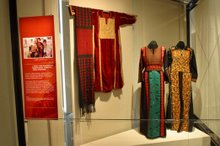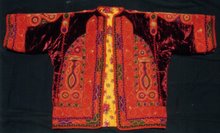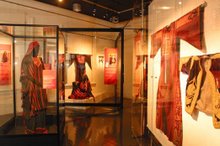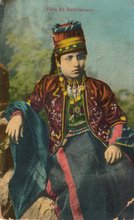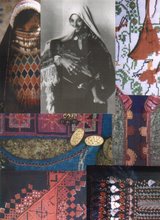 |
| source |
The second Bet Lahem Festival is on next month. It's organized by the Holy Land Trust, and it's going to be terrific this year. Have a look at the links below:

 |
| source |
 |
| Enaya Othman holds one of the handmade items featured in “Beyond the Veil”Michael Sears source |
"is a special exhibition created as a joint project between MPM and the Arab and Muslim Women's Research and Resource Institute (AMWRRI), showcasing the dress of Muslim women from the Milwaukee area and exploring some enduring traditions in Muslim clothing. This exhibit aims to expand public knowledge concerning the significance of cultural clothing beyond stereotypes, and to give women from the Milwaukee community an opportunity to speak about their experiences both here, and in the diverse societies of their ethnic descent.
"This exhibit, supported by a grant from the Wisconsin Humanities Council, features 30 traditional outfits, as well as various special occasion and day-to-day use items like table sets and jewelry, owned by local women with strong ethnic ties to countries ranging from Jordan, Palestine, and Kuwait, to Morocco, India, and Pakistan.
"Beyond the Veil caps a four-year-long project led by AMWRRI dedicated to the study of the attitudes toward cultural clothing among the Muslim and Arab women of the Milwaukee area. Testimonies gathered here highlight the importance of cultural clothing and its meanings to Arab and Muslim women who migrated from various Muslim countries, and illustrate how women from different generations continue to recreate and adapt elements of their cultural dress to meet modern tastes."Annysa Johnson published the following article "Milwaukee Public Museum show explores relationship between Muslim clothing, identity" in the Journal Sentinel on May 25, 2014:
"In December, on the eve of her niece's wedding, Enaya Othman gathered with the women of her family for the traditional painting of the henna on the bride and her attendants.
"Like the others, Othman donned a traditional gown, a colorful Roomi thob of her native Palestinian territories. But this was not just any dress. Handmade in her homeland, it was fashioned from pieces of a linen garment worn by her late mother. The cross-stitching of its silk embroidery tells the tale of its origins in her family's home region of Ramallah al-Bireh.
"Othman's thob is now on display at the Milwaukee Public Museum as part of a dazzling new exhibit that exploresthe complex and evolving relationship between traditional dress and identity for Muslim women whose families immigrated to Wisconsin from around the world. "This dress is connected to my heart, my traditions, my mother's traditions," said Othman, an assistant visiting professor of Arabic language, culture and history at Marquette University and the driving force behind the exhibit, "Beyond the Veil." "It tells my mother's story, and I will one day hand it to my daughter, so she can tell her story."
"Beyond the Veil," which opened to the public this month, grew out of an oral history project launched in 2010 by the nonprofit Arab and Muslim Women's Research and Resource Institute co-founded by Othman through her work at Marquette.
"That project transcribed the narratives of dozens of Arab men and women, both Muslim and Christian, whose families have settled here over the past century. Recurring themes, especially among the Muslim women, centered on appearance and identity and how the clothes they wore opened them to stereotyping and discrimination and affected their adjustment to life in the United States, according to Othman.
"What researchers found were varied and complex relationships to traditional dress: women who wore it exclusively, and others just for special occasions. There were women who embraced it, yet fought against being stereotyped by it; and younger women who were rediscovering and modernizing it. Depending on the woman, the clothes reflect a sense of modesty or pride; a connection to history, to faith, culture or regional identity.
Visitors milled through the exhibit at its opening, many of them first-generation immigrants who had donated items for the show.
"My daughter-in-law wore this for her henna night; we had it specially made," said Ibtisam Ahmad, pointing to an elaborate velvet mallaka embroidered with leaves and flowers in brilliant jeweled tones, the gold coins of the bride's dowry sewn into a velvet sash around the neck.
"Museum President Dennis Kois called it "one of the most beautiful" textile exhibits that he had seen. Middle Eastern scholar Iman Saca, whose mother founded the Center for Palestinian Heritage and Embroidery Preservation in Bethlehem, spoke on the history and symbolism of the art, and the importance of such exhibits in keeping that history alive.
"Every stitch, every color, every design had meaning," said Saca, director of the Middle Eastern studies program at Saint Xavier University in Chicago. "And hopefully, we can preserve that meaning."
"The exhibit is a collaboration between the Arab and Muslim Women's Research and Resource Institute and the Milwaukee Public Museum. It was financed in part with a $10,000 grant from the Wisconsin Humanities Council.
"The show is a glimpse at the diversity of Wisconsin's Muslim community, through the lens of fashion. It features 30 traditional garments, jewelry, accessories and other artifacts from a wide swath of the Muslim world, divided into five regions: Bilad al-Sham, which encompasses modern-day Syria, Lebanon, Jordan and the Palestinian territories; the Gulf States; North Africa; South Asia; and Turkey. It's a visual feast of color and texture, from the velvet and embroidered Palestinian mallakas to the flowing abayas of Saudi Arabia and the silk sari and gauzy shalwar kameezes of India and Pakistan.
"All of the items were donated by members of the local Muslim community. Many have been passed down from mother to daughter or were specially made by seamstresses in their countries of origin. Some feature designs unchanged for centuries; others reflect a kind of globalization of design with the melding of motifs across cultures. "It shows how all these regions are being mingled together by immigrant women to make their own cultural clothing," Othman said. "It's not anymore just traditional — something in the past — but it is something alive for today."If you can't make it to the exhibition, why not take a moment to view this You Tube video of a Henna Night event the Arab and Muslim Women's Research and Resource Institute was involved with :)
 |
| source |
"Stop by MECA's office tomorrow to purchase crafts and edibles including pottery from Jerusalem and Hebron; embroidery from refugee camps in Gaza, West Bank and Lebanon; hand-carved olive wood by artisans and hip designers in Bethlehem; award-winning fair trade Palestinian olive oil; jewelry from women in Jerusalem and Ramallah; and much more! The sale supports artisans and cooperatives in Palestine with proceeds going to MECA's work with children and families in Palestine and Lebanon."
 |
| source |
 |
| Intifada Dress Palestine Costume Archive collection |
 |
| Portrait of Lydie Bonfilsprivate collection documentation of Fouad Debbas, TFDC source |
"Photography arrived in the Middle East in 1839, the same year that Louis-Jacques- Mandé Daguerre produced his first daguerreotype in France[1]. Félix Bonfils, a French printer who migrated from France to Beirut along with his family in 1867, established one of the first professional photographic studios in the Middle East. Very little is known about women photographers in the region. Félix’s wife, Lydie Bonfils, can be considered the first professional woman photographer in the region.
"This blog will focus on the Bonfils production and especially on the photographs that could be attributed to Lady Bonfils. The Fouad Debbas Collection, based in Beirut, Lebanon, is the most important private collection of photographs and archives of the 19th and of the first half of the 20th centuries currently conserved in the Middle East, with approximately 40 000 photographs of the region. EAP 644 is currently focusing on digitization and assessment of the Debbas Bonfils collection
"Much has been written so far about the Bonfils family and their photographic establishment in Lebanon. From the moment they moved from France (Gard) to Beirut, Lebanon, until the establishment was sold to Abraham Guiragossian in 1907, Félix (father), Lydie (mother) and Adrien (son) produced one of the largest bodies of photographic work in the Middle East...."We have several Bonfil photographs in the Archive's collection, including the one below, which is also illustrated in the post.
 |
| Group of Bedouins from Jericho c.1876-85 albumin print, Maison Bonfils TFDC_520_034_0644 source |
"Traditionally, all photographs signed Bonfils were attributed to Félix, but it is now clear that both Lydie and Adrien contributed to the firm’s pictorial output. Specific authorship, however, is at best very speculative…"
 |
| Woman from Nablus c. 1876-85 albumin print attributed to Lydie Bonfils (?) TFDC_139_026_0619 source |
"Due to social conventions in the Middle East, it is presumed that Lydie made the photographs of female subject."But Lydie's role it appears was much wider. We encourage all Archive friends and Education officers to read Yasmine Chemali's beautifully researched and very interesting post, which you'll find here :)
 |
| Young woman from Lebanon c. 1876-85 albumin print attributed to Lydie Bonfils (?) TFDC_520_002_0257. source |
 |
| Kurd Street Sweeper, Beyrouth Evelyne Bustros and Georges Cyr "Lebanese and Syrian costumes" 1939 Publisher: Beirut, Lebanon: Impimerie Catholique |
 |
| Alaouite women Evelyne Bustros and Georges Cyr "Lebanese and Syrian costumes" 1939 Publisher: Beirut, Lebanon: Impimerie Catholique |
"Already one of the first women in the 20th century to claim recognition in literary and political circles, Evelyne Bustros garnered another honor Tuesday when the Francophone Summit’s cultural committee dedicated a conference in her name.
"Held Tuesday at the Rencontre des Cultures pavilion at Riad Solh Square, the conference was conducted by Ghassan Tueni, the publisher of Beirut daily newspaper An-Nahar, with Culture Minister Ghassan Salameh in attendance.
"Bustros, who was born in 1878, emerged on the literary scene with the 1926 publication of her first novel, The Hand of Allah. This effort, the first French novel published by a Lebanese woman, thrilled reviewers as a genuine exploration into the meaning of Arab identity in a French colonial world. Only after its distribution in Egypt did the novel appear on Lebanese book shelves. Girded by this triumphant debut and her increased popularity, Bustros became active in the Lebanese feminist movement, organizing powerful demonstrations to promote women’s rights, according to Tueni. “The emotion was so great when one of these demonstrations happened to coincide with a march, which we organized to demand independence (from the French mandate),” Tueni recalled.
"Bustros’ political concerns and nationalist sympathies extended her enthusiasm well beyond women’s issues and literature. Among the few women to claim a prominent political role in the struggle for independence against the French, Bustros was the only female signatory of the National Pact’s preliminary draft in 1937, Tueni said admiringly.
Until her death in 1971, she wrote novels, chronicles, essays, and poems whose force continues, even today, to resonate artistically and politically. Ever founding literary and political clubs, Bustros helped, in the 1930s, to establish the first club to include both Muslim and Christian authors. “Evelyne left behind a great heritage of which we are very proud,” Tueni exclaimed. Bustros’ complete works are available in a single anthology, published by Dar an-Nahar."
 |
Hauranese Bride
Evelyne Bustros and Georges Cyr "Lebanese and Syrian costumes" 1939 Publisher: Beirut, Lebanon: Impimerie Catholique |
"Businessman Raymond Audi, one of Lebanon's most active arts patrons, has gathered together the privately held works of French modernist painter Georges Cyr for a two-month exhibition entitled "Georges Cyr dans les collections libanaises."
"The exhibition includes examples of Cyr's work from many stages in his artistic life, but it focuses on the art he produced after he moved to Beirut from Normandy in 1934. "Cyr represents two important traditions in the history of art in Lebanon," says Sarah Rogers, an art historian and PhD candidate in the history, theory and criticism of art and architecture program at the Massachusetts Institute of Technology. Rogers is particularly knowledgeable on Lebanese art history and has taught in the department of visual art at Notre Dame University in Zouk Mosbeh.
"First is the cultural crossroads that have long given form to art in Lebanon; the French Mandate opened the country more to all things French, and because of the legacy of the laissez-faire economy put into place by the mandate, Beirut's role as a locus for the trafficking of goods and services, and artists, only further developed post-1943," adds Rogers. "Secondly, his atelier served as an artistic meeting place and studio for training others interested in art which is part of a longer history of art in Beirut. For instance, before the Lebanese Academy of Fine Art [ALBA] established its art department in 1943, followed by the American University of Beirut's 10 years later in 1953, artists in Lebanon learned their craft in the studios of the previous generation such as [Charles] Corm and [Habib] Srour."
"The Cyr collection on view now is made up of 96 privately owned paintings organized in six rooms. The exhibition includes works in pencil, ink, watercolor, oil and gouache. The paintings chart his career through the first half of the 20th century and encompass a broad range of modernist styles ... Cyr's works are arranged in roughly chronologically order, and it is striking that even shortly before his death in 1964, he was still producing a great range of styles - from light, playful watercolors of people at a picnic to heavy cubist oils and landscapes""Light, playful watercolours" is a good description of the art works in "Lebanese and Syrian costumes".
 |
| Village Woman of the Homs Plain Evelyne Bustros and Georges Cyr "Lebanese and Syrian costumes" 1939 Publisher: Beirut, Lebanon: Impimerie Catholique |
 |
| Bedouin woman of Akkar Plain, Lebanon Evelyne Bustros and Georges Cyr "Lebanese and Syrian costumes" 1939 Publisher: Beirut, Lebanon: Impimerie Catholique |
 |
| Peasant woman of the Hama Plain Evelyne Bustros and Georges Cyr "Lebanese and Syrian costumes" 1939 Publisher: Beirut, Lebanon: Impimerie Catholique |
 |
| Village Women of Ferouz and Zaidal in the Syrian Plain Evelyne Bustros and George Cyr "Lebanese and Syrian costumes" 1939 Publisher: Beirut, Lebanon: Impimerie Catholique |
 |
| Homs midwife Evelyne Bustros and Georges Cyr "Lebanese and Syrian costumes" 1939 Publisher: Beirut, Lebanon: Impimerie Catholique |
 |
| Woman of the Djebel Druze Evelyne Bustros and Georges Cyr "Lebanese and Syrian costumes" 1939 Publisher: Beirut, Lebanon: Impimerie Catholique |
 |
| Syrian Bedouin Woman Evelyne Bustros and Georges Cyr "Lebanese and Syrian costumes" 1939 Publisher: Beirut, Lebanon: Impimerie Catholique |

